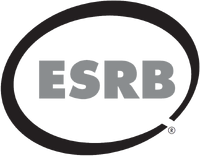The Entertainment Software Rating Board (ESRB) is the American organization which rates the video games released in North America. In Australia it is the Australian Classification Board (ACB), in Europe it is the Pan-European Game Information (PEGI) and in Germany it is the Unterhaltungssoftware Selbstkontrolle (USK). It is the video game equivalent of the Motion Picture Association film rating system. The ESRB has been widely criticized for its lack of strictness, with its critics stating that the ESRB rates games much lower than it deserves, so more copies of the game will be sold.[citation needed]
Current Ratings
| Image | Name | Meaning |
|---|---|---|

|
Everyone (E) | Titles rated E (Everyone) have content that may be suitable for all ages. Titles in this category may contain minimal cartoon, fantasy or mild violence and/or infrequent use of mild language. It is the equivalent of a G rated movie. |

|
Everyone 10+ (E10+) | Titles rated E10+ (Everyone 10 and older) have content that may be suitable for ages 10 and older. Titles in this category may contain more cartoon, fantasy or mild violence, mild language, and/or minimal suggestive themes. It is the equivalent of a PG rated movie. |

|
Teen (T) | Titles rated T (Teen) have content that may be suitable for ages 13 and older. Titles in this category may contain violence, suggestive themes, crude humor, minimal blood and/or infrequent use of strong language. It is the equivalent of a PG-13 rated movie. This is the highest rating Nintendo allows for their games. |

|
Mature 17+ (M) | Titles rated M (Mature) have content that may be suitable for persons ages 17 and older. Titles in this category may contain intense violence, blood and gore, sexual content, knives, alcohol and/or strong language. It is the equivalent of an R rated movie. Although no games directly made by Nintendo were rated M, a few published by the company alongside another (Eg. Rare) have this rating. |

|
Adults Only 18+ (AO) | Titles rated AO (Adults Only) have content that is explicitly for persons 18 years and older. Titles in this category may include extreme violence, frequent use of strong language and/or graphic sexual content, pornography and nudity. It is the equivalent of an NC-17 rated movie. Only 24 games have been given this rating although very few are solely for violence. No Nintendo game ever received this rating. |

|
Rating Pending (RP) | Titles listed as RP (Rating Pending) - have been submitted to the ESRB and are awaiting final rating. (This symbol appears only in advertising prior to an upcoming game's release.) It is the equivalent of Not Rated (NR). |

|
Rating Pending - Likely Mature 17+ (RP) | Titles listed as RP 17+ (Rating Pending - Likely Mature 17+) - have been submitted to the ESRB and are awaiting final rating, but are anticipated to carry a "Mature" rating. (This symbol appears only in advertising prior to an upcoming game's release.) It is the equivalent of Not Rated (NR). |
Former Ratings
The Legend of Zelda Ratings
Although the The Legend of Zelda series have been in existence longer than the ESRB, every mainline game released prior to its founding (Link's Awakening and earlier) currently has an ESRB rating due to re-releases. Most have been rated E (Everyone), though recent games often were E10+ (Everyone 10+), and a few are rated T (Teen). One game has its original rating changed to a higher level in its re-release.
Trivia
- The ESRB was founded in 1994 by a Congressional hearing one year prior, due to the then-rising of violent video games seen throughout the early part of the decade, starting with Doom, Night Trap, and Mortal Kombat. The original Mortal Kombat in particular, due to its infamous "Fatality" mechanic, was widely believed by many to be the main reason of the ESRB's founding. Despite this, games with controversial content have existed as far back as 1976 with a primitive arcade driving game called Death Race.

- Arguably the most iconic game of The Legend of Zelda series, Ocarina of Time, was nearly given a much higher rating than it obtained in its original release. During the final battle against Ganon, when Link must deliver the final blow against his archenemy, he ultimately slashes the beast's face multiple times with the Master Sword before brutally thrusting it into his mouth, resulting in red blood splattering (Ganondorf also coughs blood when defeated). Because such content is normally seen in a game rated Teen or higher, but the game itself was actually rated Everyone (plus Nintendo itself has a strict policy against graphic violence), this was met with controversy and Nintendo quickly changed it to green in subsequent ports and re-releases to prevent the risk of the Nintendo 64 title being re-rated to this level, as well as its Nintendo 3DS remake Ocarina of Time 3D instead has the sacred blade hitting Ganon's forehead. Strangely, stained red blood is still found in the Bottom of the Well and Shadow Temple in all versions of the game, and the remake was given the Everyone 10+ rating.
Notes
- ↑ Majora's Mask was rated E by the ESRB until it was re-released via Nintendo Switch Online + Expansion Pack.





